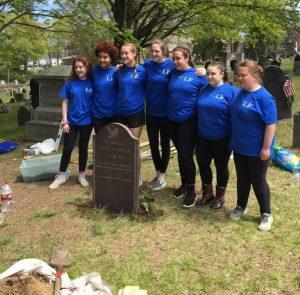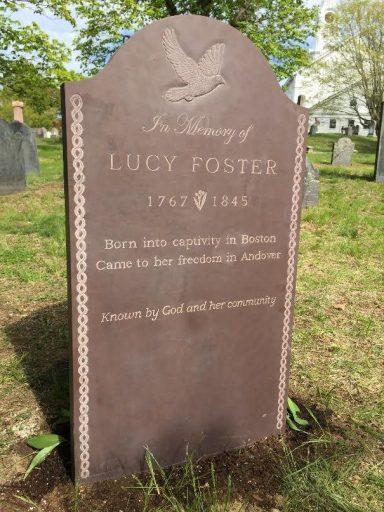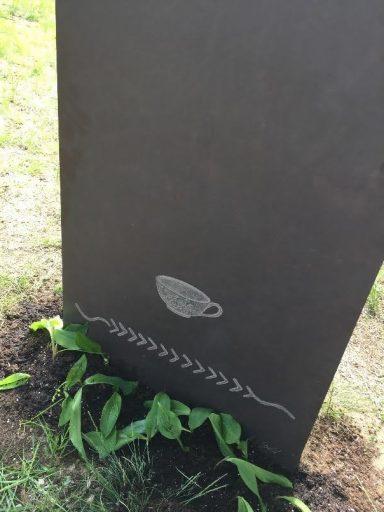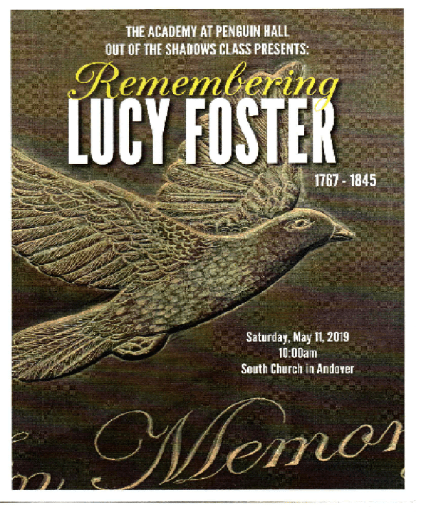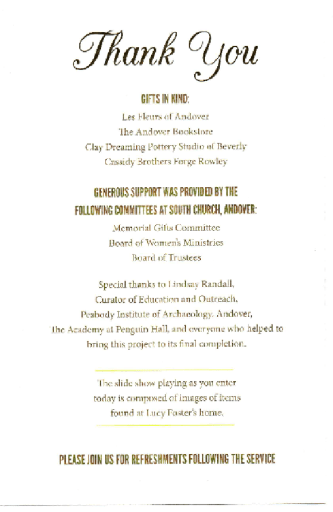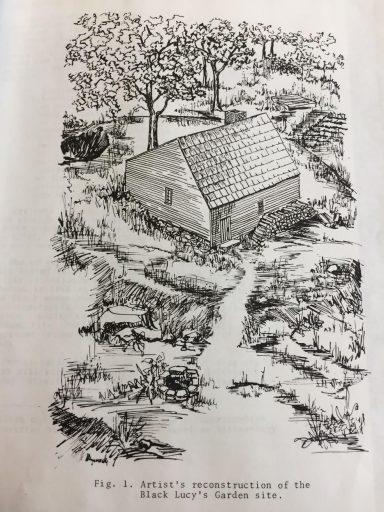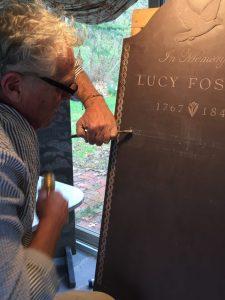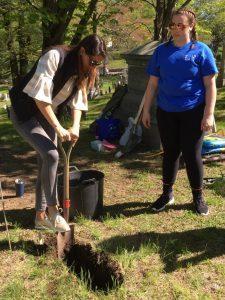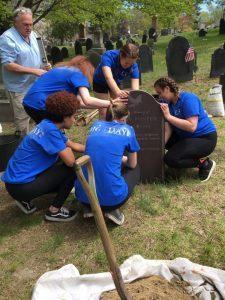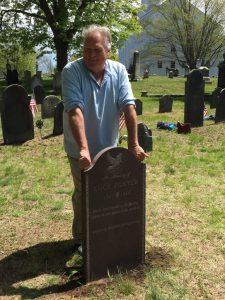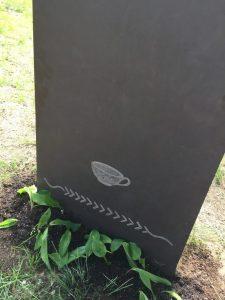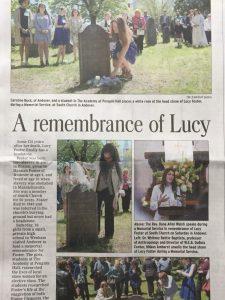South Church in Andover was established in 1711 as the “Church of the South Parish in Andover”. In 1709, the South Parish in the Town of Andover was established as the second parish in Town, with the first parish being what is now North Andover. Our historical cemetery only has 113 headstones from the 1700s when over 1500 deaths were recorded by the ministers in our first 90 years? And only 6 remain of the original 35 members of The Church of the South Parish? Where is everybody?
In combing through the Andover Vital Records and genealogies, I have been able to add over 900 people to the database from those early generations, assigning them to a later generation lot to group them together, for lack of any idea of where they are actually buried. Even though they do not have a headstone, they are at least remembered in our database. One of those persons is Lucy Foster.
Lucy Foster died in 1845 at the age of 78, and was a church member for 52 years. She was brought to Andover at age four in 1771 as a slave to Hannah Foster, a gift from her husband Job, who had her baptized here at South Church. After Job died, Hannah married Philemon Chandler, and out lived him as well. Philemon’s will gave her charge of his house, horse, livestock and food to look after Hannah. When Hannah Chandler died in 1812, she left Lucy an acre of land, a cow, and $126 (which scholars believe may have been a reparation or back wages). The will executor, Capt. Joshua Ballard, raised a subscription from church members to build Lucy a cottage, which became known as Black Lucy’s Garden.
Lucy’s death is noted in our church records indicating she is buried here, but we do not know where. Interestingly, she is not listed in the Negro section, but simply as Foster, Lucy. I ‘assigned’ her to a lot where it is likely where Hannah, Job, Philemon, and several other family members from the neighboring Chandlers and Fosters are buried. And in the same area, are the Ballards. It seems as likely an area as any for her to be, it certainly feels that way to me.
In the Fall of 2018, Elaine Clements of the Andover Center for History & Culture and I had an opportunity to talk to Caroline Buck, 18, of Andover, and her teacher Dr. Linda Meditz of The Academy at Penguin Hall in Wenham, about Lucy. The class was titled, “Out of the Shadows”, a social studies class looking for a local former slave woman who did not have a headstone that they could study for the year. It just so happened that an archeological dig of Lucy’s home was conducted in 1943, revealing a great deal of information about her independent life. In all studies about Lucy, the South Parish Church is prominently featured as primary evidence in factors which shaped her life. What is extraordinary about Lucy, is that she is ordinary, has a story to tell, and she is a soul member and sister in Christ who worshiped here her whole life in Andover, but few know about her.
Lucy attended church with her family and other servants. Negroes, whether slaves or not, and indentured servants (black or white) all sat in the balcony or in the back of the Meetinghouse, where she likely sat as well. She joined South Church in 1793 as a 26 year old freewoman likely living with Hannah and Philemon. It was said that Lucy had a lovely singing voice, and she was educated.
Joshua Ballard also grew up with Lucy as a neighbor, and served on the South Church Benevolent Fund. He made sure to supplement her income from her tea service tavern with one to five dollars annually to make sure she could continue to live independently. As Lucy and her garden were known as a spot for gathering in the Negro community, scholars wonder if she was also a stop on the underground railroad, where runaways could trust those who looked like them. Of course this would never have been shared with the white community, even other white people on the line. If it was dangerous for white people to hide runaways, it was a deadly consequence for black people to be discovered. Lucy had all the opportunities to be a stop with runaways hiding in plain sight. Known by God.
The class embraced the life of Lucy, perhaps realizing she became free in 1783 when she was 16 years old, their age. The class had a lone African American young lady, and they made a pact for checking in with each other when the topics became uncomfortable. The capstone for the class was to erect a headstone for Lucy in the Spring of 2019, with a dedication and memorial service. Please read the article which appeared in the Salem News, Andover Townsman, and The Andovers Magazine to learn more about the class endeavor. They raised over $3000 to make this happen, with South Church’s Board of Women’s Ministry, Board of Trustees, and Memorial Gifts Committee giving $1250 toward the goal.
After the article appeared in the Salem News, Dr. Meditz was contacted by a Newbury artist, historian, and stone carver who works in slate, recognizing that the design is something he and the girls can work on together. Michael Updike, who is the son of author John Updike, brought his tools and samples of slate to their class for them to learn more about headstone art and symbolism, and carving! He found a distinctive, purple and chocolate slab of slate for Lucy.
The class visited the Peabody Archeology Museum at Phillips Academy to see the artifacts found. They learned from the curator how items were sorted, cleaned, stored, and preserved. They saw eyeglasses, buttons and sewing materials, clay pipes, pewter plates and wooden serving utensils, and a great many cups and saucers. They learned about Lucy’s home and how her land and buildings were situated. Unfortunately, nothing remains on the acre she was given.
And it just so happens that a scholar at UMass Amherst, Dr. Whitney Battle-Baptiste, who wrote a book called Black Feminist Archeology, had written a chapter about Lucy and the woman archeologist from 1943! Her insight into the findings and culture of Lucy’s lifetime were another gift to this class. Dr. Battle-Baptiste consulted in the wording of the headstone to not be in the traditional white voice used forever as a means of honoring an African-American posthumously. Specifically, call slavery what it is, captivity. Where Lucy’s story is one of being a beloved member of the community, we and the class refused to perpetuate the myth that slaves in the North were treated just fine. Studying Lucy and her contemporaries exposed the many flaws in those arguments.
As a 52 year member of South Church, I felt strongly that the last line was important, as there is so much we do not know about Lucy. This appropriate wording has allowed South Church to frame this story of Lucy, brought to Andover as a 4 year old slave, a freedwoman, a church member, her legacy, and how we at South Church have embraced this gift of a headstone and to be here for her.
The headstone reads:
In Memory of
Lucy Foster
1767 – 1845
Born into captivity in Boston
Came to her freedom in Andover
Known by God and her community
The artwork was designed by the class. The dove represents her freedom. The design around the edges was from a pattern on a cup and saucer found during the archelogy dig that the girls observed at the Peabody. The small flower between her birth and death years is also from a tea cup pattern. In a bit of whimsy, Michael carved another pattern on the back, and a lovely little tea cup.
Pastor Dana Allen Walsh met with the class to plan a service for Lucy and a dedication of the headstone on Saturday, May, 11, 2019. Dana quickly put the girls at ease in preparing the service and how they wanted to both tell Lucy’s story, but their story as the class evolved. Each girl spoke about how they wanted to make sure that Lucy was truly having a memorial service. They wanted it to be appropriate for our church member and also bring closure to remembering their new friend in stone for us all to tell her story. We left with a program already well crafted. We loved this opportunity to be Lucy’s agent as a child of God buried here, and an opportunity to share all our history and own the facts of Northern slavery that have slipped away.
We had a Dig Day the Thursday before the service to place the headstone in the ground. Michael brought the stone, Dr. Battle-Baptiste instructed us on how to dig the hole archaeology style. The staff came out to help and meet everyone. During lunch, we all wrote a personal note to Lucy, not sharing with each other. The notes were placed in a jar, and we dug a small hole behind the headstone as a goodbye and thanks for getting to understand the life of an enslaved then independent black woman.
The service was attended by the community, the families of the girls, school administrators, and all the players in helping this class complete the project. One of the girls made a wonderful slide show of the many steps along the way which played as people entered and settled in the Sanctuary. The curator of the Peabody Archaeology Museum brought many of Lucy’s items from the dig. Steve’s Flowers in Town sent a beautiful blue bouquet as it seemed to be Lucy’s favorite color, and a carnation for each in the class to lay at the headstone. The girls made a tiny teacup thank you gift for all who had been a part of the research and service.
To me, it was a humbling reward to be able to remember one person of so many who do not have headstones. She was one of the many black women in New England who were invisible and considered objects and property, and most likely to only show up as a transaction, a vital record, or in this most unusual case, a will and an archaeology study. The class learned about our American history and society from the inside out. Dr. Meditz cast a wide net that caught Andover, South Church, a stone carver, an archeologist, the parents of these students, the administration at the Academy, where we all saw young scholars engaged in hands-on research and learning in a humble, respectful, and reckoning way with a difficult subject matter with maturity far beyond their years.
We hold humbly that we are the gracious recipient of her legacy and of a headstone in memory of Lucy Foster, “Known By God.”
Charlotte Lyons, Historian,
South Church in Andover

